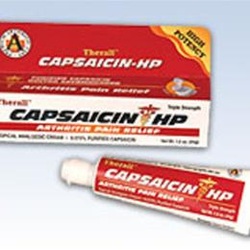


#Capsaicin cream nausea full#
In true CHS, the recovery phase follows cessation of cannabis use, though symptoms can persist for weeks prior to full remission. 6 Rome IV criteria include this feature as a “supportive remark” (Table 19,10). In both phases, compulsory hot bathing for relief of symptoms is common for example, in one systematic review, this was reported in 10 of 14 pediatric cases.
#Capsaicin cream nausea plus#
The hyperemetic phase includes acute-onset nonbilious vomiting up to several times per hour, plus diffuse abdominal pain. 1,6 The prodrome comprises months of morning nausea while chronically using cannabis and is often accompanied by weight loss. 14,15 Clinical PresentationĬHS has 3 clinical phases: prodromal, hyperemetic, and recovery. MorbidityĬHS can lead to repeated presentations and admissions, with sequelae including hypovolemia, electrolyte derangements, acute kidney injury, 13 esophageal injury, weight loss, and prolonged debility.6 There are multiple reports of fatalities believed to be related to CHS, including 1 from torsade de pointes due to electrolyte derangement and antiemetic-driven QT prolongation. 12 Clinicians can help mitigate further harm and disparities through careful and thorough treatment of all patients with possible CHS. 9,10Ĭannabis use in the United States has long been associated with racist and classist laws and law enforcement (despite liberalization 11), whereas access to health care, including mental health– and substance-related care, remains disparate and unjust.

6-8 One research group emphasizes challenges in both diagnosis and epidemiology due to widespread use of cannabis to self-treat nausea and the relatively low rates at which patients follow up and stop using cannabis-which is required to meet current Rome IV diagnostic criteria for adults ( Table 1). 5Īcross study findings, CHS tends to present in the late teens or the 20s. 4 Findings of a 2018 study estimated that 2.8 million people in the United States (approximately 1% of the population) use cannabis chronically and have symptoms consistent with CHS. A 2015 study of emergency department (ED) presentations in a US state following legalization of medical cannabis found nearly double the rate of cyclic vomiting presentations and higher rates of cannabis use among these patients. Prevalence of CHS is uncertain but likely increasing. With expanding medicinal and recreational use, decreasing perception of risk, 2 and increasing potency of cannabis, 3 the burden of CHS on patients and health care providers will likely continue to grow. 1 First described in 2004, CHS remains poorly understood and challenging to diagnose and manage. Cannabinoid hyperemesis syndrome (CHS) is a disabling illness characterized by episodic acute vomiting and associated with chronic cannabis use.


 0 kommentar(er)
0 kommentar(er)
